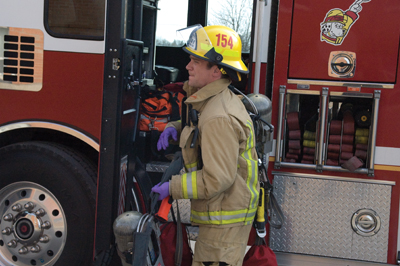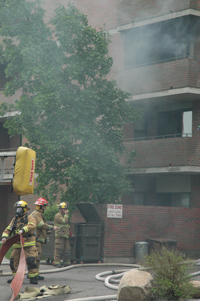
Features
Health and wellness
Hot topics
Occupational athletes
Firefighters and EMS workers often suffer injuries in the line of duty. As “occupational athletes” first responders often face the risk of injury and must frequently cope with chronic pain and disability.
April 12, 2010
By Rosie Lombardi
Firefighters and EMS workers often suffer injuries in the line of duty. As “occupational athletes” first responders often face the risk of injury and must frequently cope with chronic pain and disability. An innovative study is looking to the sports world for new approaches to reduce that risk. Researchers from the University of Waterloo in Ontario, the Andrews Institute for Orthopaedics & Sports Medicine in Pensacola, Fla., and the Pensacola Fire Department are working together on the multi-disciplinary project to find ways to develop effective injury prevention programs by incorporating job-related biomechanics.
Moving to a new paradigm
Many conventional practices in physical training are very misguided, says Tyson Beach, a researcher at Waterloo’s department of kinesiology. “In their quest to achieve optimum fitness, firefighters and other occupational athletes often destroy themselves in the gym.”

|
| The IAFF is working on a study to demonstrate the benefits of comprehensive health and wellness programs in reducing health-care costs for firefighters, who risk injury on the job in day-to-day operations and during training.
Photo by Laura King
|
That’s because many people go into training without considering the biomechanics of their movement systems. Traditional training typically focuses on measures of fitness – how strong or fast firefighters can get – without considering how a person moves while achieving those goals, says Beach. This does not physically prepare occupational athletes for the demands of their jobs.
While this biomechanical approach is well-established in professional sports, it is seldom applied to occupational athletes. “Coaches say you can’t run to train – you have to train to run. If you run to train and do it badly, you’ll hurt yourself,” he says, pointing out that there is a large body of evidence from recreational athletes to support this view. “Injury rates for runners are astronomically higher than any other recreational activity. They get shin splints, plantar fasciitis and other chronic problems. But if people are prepared and conditioned properly, they can avoid those injuries.”
People develop their particular movement patterns at an early age, and these may predispose them to musculoskeletal problems later on if they don’t learn how to move properly. “There are many things your body adapts to over time. These adaptations aren’t necessarily anomalous, but they may create problems when you do things that are physically challenging.”
Interestingly, age does not play as big a role in injuries as the way people move, he adds. “A 25-year-old firefighter may be very strong and fast, but he may activate his muscles in ways that place him at greater risk than a 50-year-old who is less fit but moves with the proper biomechanics. He may not hurt himself at first, but if he continues for five to 10 years, he may get chronic injuries.”
The major thrust of the Waterloo study is to determine which specific movements and training can help firefighters perform tasks such as pulling hoses and breaking doors without hurting themselves in the long run, says Beach. “Not all injuries can be prevented, but we think a sub-category can be.”
To determine which injuries can be avoided, the study divided participating firefighters from the Pensacola Fire Department into two groups who trained three times a week for 12 weeks. One control group did a traditional fitness-based program with cardio, running and weights. A second test group did a similar program, but with greater emphasis on how they moved while they trained, mimicking the movements used on the job such as climbing a ladder.
“In this group, we tried to transfer their training to their occupation, so they’ll use the same approach they used in the gym when they climb a ladder or bust a door,” says Beach. Movement is a skill, like throwing a baseball, he adds – when people are coached a certain way, these movements become subconscious over time.
Another part of the study focuses on screening firefighters before they even enter a training program to determine if aberrant patterns in their movement systems can be identified and corrected early.
Many chronic pain conditions could be avoided if people were treated earlier and taught how to correct their alignment problems before they escalate, agrees Dr. Wolf Schamberger, a clinical associate professor of rehabilitation medicine at the University of British Columbia and author of The Malalignment Syndrome.
“Firefighters can do this on their own if they get guidance on how to check and do some simple corrective exercises. If they’re done on a daily basis, the body eventually grows accustomed to the new aligned pattern, and it stops the advancement of problems.”
Collection of the data for the Waterloo study was completed in the fall of 2009 and the researchers plan to release their findings later this year when the analysis is completed. High-tech gear such as sensors, force plates and 3-D body positioning was used in the study to collect objective evidence.
Beyond firefighters, the study will have broad implications for other occupational athletes, such as EMS workers, who perform demanding tasks and will bring more science to this area. “People can learn from this paradigm and start looking at how people perform tasks to prevent injuries,” says Beach.
Changes afoot in physical training
Firefighting associations are looking forward to the study, as job-related injuries exact a huge toll. “Anything we can do to prevent injuries is a step in the right direction,” Murray McGrath, WSIB committee chair for the Ontario Professional Fire Fighters Association.
 |
| The University of Waterloo study is to determine which specific movements and training can help firefighters perform tasks such as pulling hoses and breaking doors without hurting themselves in the long run.
Photo by Laura King
|
In Ontario, between 800 and 1,000 firefighters suffer loss of time due to injuries annually, says McGrath. The average claim costs about $21,000 for loss of pay and healthcare benefits, which means loss-time injuries cost about $16 million annually for Ontario alone. These costs aren’t tracked nationally in Canada, but McGrath believes other provinces’ experiences are similar, based on their populations.
Even more important is the loss of quality of life. Many firefighters sustain multiple injuries, which can have a deleterious lifelong impact. “I haven’t done front line work in the past 12 years since I assumed a management position, but I still have to go to physiotherapy for flare-ups to this day,” says Bruce Burrell, Calgary-based president of the Canadian Association of Fire Chiefs, who injured his spine, ankle and shoulder during his years of active duty.
Although firefighters are often in dangerous situations, McGrath points out that most injuries are actually caused by performing routine, repetitive tasks while wearing and carrying heavy gear. The weight exerts an enormous strain by itself, and it also deters the use of proper biomechanics because it throws firefighters off balance.
Most fire departments have expectations their staff will maintain a high level of fitness but few have formal health and wellness programs in place. McGrath and his counterparts in other provinces are working to change this state of affairs.
“We’re pushing for more sanctioned voluntary fitness program and trying to establish them within integrated health and wellness programs. We’re trying to do a soft sell on them at this point to make it voluntary and get management and the unions to endorse them,” he says.
However, there’s a lot of resistance to this change. Cash-strapped municipalities are reluctant to spend taxpayer money on these health and wellness programs. “This is short-term thinking, as they see this as an extra cost instead of an investment that will be recouped in the future in lower costs to care for injured firefighters,” he says.
And firefighters themselves are also fearful. “Many who have been injured or are older are concerned that it means the end of their career if there’s a physical standard and they don’t meet it.”
Although the introduction of more health and wellness programs would be a step in the right direction, it’s still not enough, as these type of programs don’t prevent injuries. “Even the most fit firefighters experience injuries on the job, so the highest standards of fitness are not enough,” McGrath says, noting that the proper techniques that should be used while firefighters perform their regular duties are seldom considered. “Firefighters just try to get the job done as quickly and efficiently as possible before their limited air supply runs out.”
McGrath says he has a keen interest in seeing the Waterloo study’s findings later this year with a view to developing evidence-based injury prevention programs specifically for firefighters.
Another necessary step is getting evidence that can help make the financial case for injury prevention and other integrated health and wellness programs for firefighters, he adds. “Employers are focused on costs, so we need a proven case of a community that can show it saved money by adopting a program.”
A separate study is underway to do just that, says Burrell. The International Association of Fire Fighters is working on a study to demonstrate the tangible benefits of comprehensive health and wellness programs in reducing health-care costs. Under its auspices, the Calgary fire department is participating in a 10-city pilot across North America to track the health benefits and financial impact. (See Fire Fighting in Canada, August 2009.)
“We have a full-time health clinic we run that firefighters can go to, and gyms at every station,” he says, noting comprehensive programs are essential, as there are other worrisome medical trends to consider for firefighters beyond injury prevention.
“In the 1980s, we started seeing a higher incidence of occupation-related diseases. We’re the generation that paid the toll due to our occupational exposures, as we’re now seeing cancer rates for firefighters that are six times the public average. We changed the protective gear and our policies and procedures over the years to prevent this from happening to the next generation,” says Burrell.
Rosie Lombardi is a Toronto-based freelance writer.
Print this page